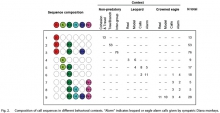Duality of Patterning
Certainty styling is being phased out topic by topic.
Hover over keys for definitions:Duality of patterning refers to the ability of human language, both signed and spoken, to form discrete meaningful units (morphemes; cf. "Rules of word formation (morphology)") from discrete non-meaningful segments (phonemes; cf. "Sound/sign patterning (phonology)"). (1) No naturally occurring system of animal communication exhibits this basic feature of human language in its entirety. However, there is some evidence for incipient aspects of duality of patterning in the call systems of Campbell's monkeys and putty-nosed monkeys. (2) In other words, individual alarm calls seem to be stripped of their intrinsic “meaning” when combined in certain ways across situational contexts ([3] and Figure 1, below). There have also been reports that after an African gray parrot spontaneously, without training, produced minimal pairs of certain words differing in only one phoneme, he was trained to produce the component phonemes of words he already knew. (4) Hockett (1960) hypothesized that this property was the last to emerge in the evolution of language, precipitated by a certain level of complexity, and this claim appears consistent with studies of emerging sign languages (5).

References
-
The gradual emergence of phonological form in a new language, , Natural language & linguistic theory, 05/2011, Volume 29, Issue 2, p.503 - 543, (2011)
-
Alex & Me, , p.232, (2009)
-
Campbell's monkeys concatenate vocalizations into context-specific call sequences., , Proc Natl Acad Sci U S A, 2009 Dec 22, Volume 106, Issue 51, p.22026-31, (2009)
-
A syntactic rule in forest monkey communication, , Animal Behaviour, Volume 63, p.293 - 299, (2002)
-
The Origin of Speech, , Scientific American, Volume 203, Issue 3, p.88-96, (1960)

